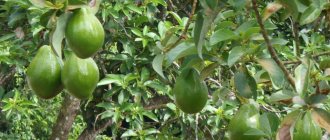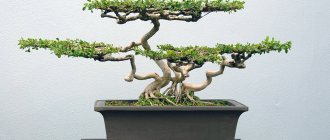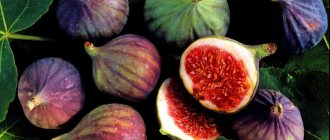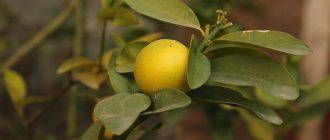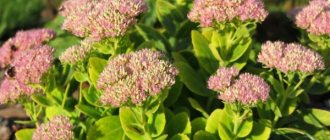Since ancient times, people have been familiar with such an evergreen fruit plant as the avocado tree. Thanks to its oily, pear-shaped fruits, it is also called alligator pear, agacat, and American persea. Today, many people want to grow such a miracle fruit at home, but to do this you need to know some secrets for caring for it.
What does an avocado tree look like?
In nature, an adult avocado tree, which belongs to the laurel family, grows up to 20 m. It has a wide crown, a trunk up to 60 cm in diameter, sharp leathery leaves with a shiny dark green upper surface and whitish lower surface. Sometimes a tree sheds its leaves, but then grows them back. It is found in tropical and subtropical regions of India, America, and Africa. The avocado fruit is a large, single-seeded, dark green berry, shaped like a pear.
An adult avocado tree whose flowering does not look very attractive can be grown at home. Its inconspicuous flowers have a greenish tint. They bloom twice a season. Initially, their stamens are pollinated by pollen from other trees, and after about a day the anthers ripen and insects transfer their pollen to other plants. Experienced gardeners recommend planting several avocado trees nearby, whose flowering times overlap.
Many novice gardeners are interested in what an avocado tree looks like at home. This exotic plant can be grown at home on a windowsill. However, its height does not exceed 2.5 m. Often its growth is limited by the size of the pot. In areas with a warm climate in the summer, the plant can be taken outside, avoiding drafts. Avocado fruits at home grow smaller in size compared to garden specimens.
Why the avocado seed does not germinate: reasons, what to do?
There are several reasons why an avocado seed does not germinate:
- First of all, this is the wrong fruit. If you choose a green avocado, then nothing will work, because the seed is unripe.
- Failure to comply with disembarkation rules. Perhaps the soil in which you planted the seed is dry or insufficiently supplied with minerals. Perhaps it simply does not pass water well and the bone dries out.
Avocado pit does not germinate
Planting avocados at home
Do you love exotic plants and would like to grow avocados at home? Then you need to find out everything about this tree: how to plant and care for an avocado, whether it can bloom at home and bear fruit. Only after this, having gained patience and armed with the necessary knowledge, can you begin the long process of growing this unusual alligator pear. An avocado tree can be grown at home on a windowsill, in a heated greenhouse or in a winter garden.
How to prepare an avocado seed for planting?
To grow an avocado tree at home, you must first select a ripe fruit. You can buy it in the store, but first check the selected avocado for ripeness: hold it between your palms, squeeze lightly and release. A ripe fruit will quickly restore its original shape. This means that it is ripe and you can safely buy it. You can also buy an unripe avocado, but before removing the pit from it, you need to let it ripen among bananas and apples, which emit ethylene gas, which accelerates the ripening of the fruit.
Cut the ripe fruit in half lengthwise and carefully remove the seed using a spoon. We thoroughly rinse it to remove any remaining pulp. There are three ways to plant an avocado seed:
- We stick toothpicks 3 mm deep into the cleaned bone on three sides, and place it with the blunt side in a glass of water. In this case, you need to make sure that only the bottom of the bone is in the water, and the puncture sites are above the water.
- We plant the peeled seed immediately in a pot of soil, leaving a third part above the surface. Its blunt end should be buried in the ground. We water once a week.
- Peel the avocado pit and immerse two-thirds of it in water. It will grow faster, and through the glass you will be able to watch the roots and stem grow.
Water for germination must be settled. You can add activated or charcoal to it. As it evaporates, water must be added. It is better to choose a large bone, which contains more nutrients. It can germinate in different periods - from a week to two months. The best time for this is spring. After the seed cracks and splits into cotyledons, roots appear from it and soon it can be transplanted into the ground.
Avocado pot
To plant an avocado seed, it is better to choose a plastic pot with a diameter of 9-15 cm and a height of about 15 cm. The container must have drainage holes to drain excess water. As soon as the sprout grows 3 cm, it is transplanted into a pot. We pour a 2 cm layer of drainage onto the bottom of the container. We make a small depression in the ground, into which we plant the sprouted seed so that its third part is above the surface of the soil.
The sprout grows very quickly at first. The avocado tree is heat-loving; growing it at home largely depends on the temperature regime. In cool summer weather, you should not take the pot with the plant outside. In winter, when the temperature drops below +10ºС, the tree can shed its leaves, and new ones will grow only in the spring.
Avocado soil
This crop does not grow well in heavy, clayey, acidic soil, so for planting it is better to prepare in advance an earthen mixture consisting of peat, coarse sand, humus and garden soil in equal parts. You can add a pinch of lime here. The day before planting the seeds, boiling water should be poured onto the ground to disinfect it. In such a soil mixture you can grow an avocado tree from a seed.
Transplantation and feeding
Avocado prefers loose and breathable soil. The best soil is made from the following ingredients:
- 1 part humus;
- 1 part garden soil;
- 1 part coarse sand;
- a little moss, expanded clay or peat.
Young avocados are replanted annually, and adult plants - every three years by transshipment in the spring. The tree grows quite large, so you should choose a large container for it.
to feed avocados twice a month in the warm season with complex mineral fertilizer.
We recommend watching a video on propagating hyacinths to make the process easy for you.
When Crassula sheds its leaves, it may be a sign of disease. Read more here.
In this article you will learn about transplanting a phalaenopsis orchid https://sad-doma.net/houseplants/orchids/falenopsis/peresadka.html, and also find video recommendations.
Planting avocados outside
In areas with a temperate climate, you can plant an avocado tree in a special hole, which will protect the plant from freezing in winter. To do this, in a sunny area, you need to dig a trench 1.5 m deep and 1.2 m wide. The fertile top layer of soil is thrown in one direction, and the rest of the soil extracted when digging the trench is thrown in the other. The wall on the north side is made vertical and sheathed with plywood or brick. The opposite slope is made flat and covered with black film.
A drainage layer in the form of pebbles, crushed stone or gravel is laid at the bottom of the pit. The excavated top soil is poured on top of it and a plant is planted in the trench, and a polycarbonate shelter is made on top. In such a shelter, an exotic avocado tree can comfortably overwinter. Those who live in the southern coastal areas can try to grow avocados in open ground.
Where is the best place to plant an avocado?
For planting avocados, an excellent option would be a place protected from cold northern winds, for example, gentle coastal southwestern and southeastern slopes. Areas with high humidity, where cold air can stagnate in winter, are not suitable for growing trees. A large avocado tree will do well in the company of another similar species, but single plantings are also possible.
Watering and humidity
water the plant abundantly, waiting until the top layer of soil dries.
During the cold season, it is necessary to reduce watering and allow the soil to remain dry for one or two days.
The home avocado plant needs high air humidity.
You can moisten the space around it or place the plant on a tray with wet filler so that the bottom of the container does not touch the water.
How to care for an avocado tree?
To grow an avocado tree at home, you need to provide it with careful care. This plant loves light, but will develop normally in partial shade. In summer, it should be shaded from the bright rays of the sun, and the best option would be to place a pot of avocado on a western window. The tree does not tolerate sudden temperature fluctuations, and in a draft it can lose all its leaves. The same can happen when the room temperature drops to +12ºС and below.
The street avocado tree is replanted once every three years. If you decide to leave the avocado tree outside in winter, then it must be carefully insulated using any covering material. When grown in a greenhouse, it must be provided with additional heating, and the trunks must be wrapped in foam rubber. It happens that a tree blooms in winter, but the buds cannot withstand the cold and fall off, although with the arrival of spring, flowering will occur on time.
How to pinch an avocado tree?
To make the avocado a real decoration of the room, you can initially plant three plants in one pot. As they grow, their flexible branches can be intertwined with each other in a pigtail. To form a lush, beautiful crown, the tree must be pinched. This is done after eight leaves appear on the stem. As a result, the side shoots of the plant will begin to grow, and as soon as they grow, their tops also need to be pinched. This is how you can get an adult avocado tree grown indoors.
How to water an avocado?
When growing avocados at home, you need to monitor the air humidity, which should be at least 70%. To maintain it, you can spray the plants with a spray bottle. In summer, an avocado tree in a pot should be watered generously; in winter, watering should be reduced. It is better to follow this rule: the warmer the air in the room, the more frequent and abundant the watering should be. This plant is especially sensitive to both drought and overwatering because its roots do not have small root hairs. During prolonged drought, the tree stops growing, sheds leaves and even fruits.
How to fertilize avocados?
When growing avocados at home, they are fed only during the period of active growth, in the spring and summer. Do this once every 2-3 weeks, using a special organic fertilizer for avocados or a balanced fertilizer for citrus fruits. In autumn and winter, the plant does not need supplements. Before fertilizing your home avocado tree, you should carefully study the instructions for using fertilizers.
How to shape an avocado tree?
For fast and uniform growth, a mature avocado tree must be pruned. It is better to do this in early spring or autumn, after harvesting. The work should be carried out very carefully, since the branches of the tree are brittle and can be easily damaged. The side shoots are cut off by about half, this should stimulate branching of the plant. On trees, all dry, damaged branches and those that grow into the middle of the tree are removed, thereby thickening its crown and preventing air exchange.
Avocado diseases and pests
The exotic avocado tree in the country and indoors can be affected by various pathogens and insect pests. Avocados that are grown in home conditions different from natural ones become especially vulnerable in this regard. The following diseases and pests are especially dangerous for this plant:
- Late blight
. The roots are affected first, then the trunk and bark of the tree. It is impossible to cure the plant; you just have to destroy it. - Powdery mildew
. A fungal disease affects the leaves and trunk of avocados. First, a plaque appears on the affected plant, and then yellow-green dried spots. Control measures: spray with fungicide. - Shield
. Settles on leaves and stems. To get rid of them, you need to wash the affected parts of the tree with a soapy solution. A large tree is treated with insecticides.
Features of care
At first I was worried that my avocado was losing its leaves. In addition, they withered gradually: first the edges dried out, the leaves became rusty in appearance, but without plaque. I attributed both fungal diseases and a lack of microelements to my tree.
As it turned out, the loss and drying of leaves are maintenance errors. Even if watering is sufficient, avocado roots lack moisture, especially in dense soil.
To avoid this, it is advised:
- wrap the roots in sphagnum moss or use hydrogel when planting,
- Spray the leaves regularly
- maintain high air humidity,
- Avoid drafts and drying out of the soil.
How to shape an avocado
Trimming and pinching are important stages in growing decorative home avocados. Without these operations, the tree will stretch out like a long rod, so it is imperative to stimulate the formation of side shoots.
It is recommended to do the first pinch after 4-5 leaves and regularly pinch the side branches.
My avocado didn't want to branch at first. I pinched the main shoot late, at a height of approx. 40 cm, because Due to improper care, the plant shed its leaves, and it was unacceptable to deprive it of precious green foliage. After the first pinching, it was not possible to achieve branching, so I pinched the trunk again when it had grown another 10-15 cm. After that, it formed 3 shoots, and the crown became more lush and attractive. Now we need to monitor and shape it regularly.
Photo: 3 avocado shoots after pinching
Watering and spraying
Avocados love moisture, so they need to be watered regularly, not allowing the top layer of soil to dry out, especially in spring and summer. In the autumn-winter period, when there is much less sun and heat, watering is reduced.
Make it a habit to spray your avocado leaves daily.
| ADVICE Decorative foliage houseplants do well in a room with a humidifier. Remember that the air in apartments is quite dry, especially during the heating season. It is not always possible to achieve the required air humidity by spraying. Therefore, I recommend installing a humidifier in the room. Air with an optimal humidity of 50-70% will be useful for indoor flowers, for you and for your children. |
Photo: young avocado - it’s time to pinch such a plant

